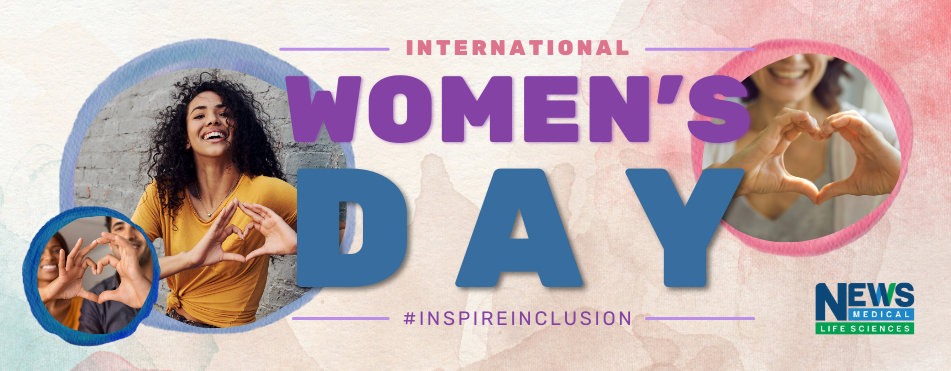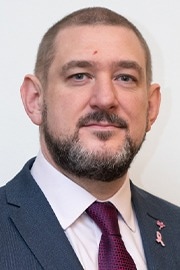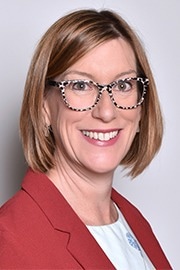In celebration of International Women's Day 2024, we're honored to host Tim Simpson and Sarah Smith from Hologic, a forefront leader in women's health. As we dive into this year's theme, "Invest in Women: Accelerate Progress" and "#InspireInclusion," let's explore how Hologic's pioneering work and dedication align with these powerful calls to action.
Join us as we discuss the crucial role of investment in women's healthcare and the innovative strides Hologic is making toward inclusive and progressive healthcare solutions.
Firstly, please introduce yourself and Hologic. More specifically, how does Hologic's mission align with the 2024 International Women's Day theme of "Invest in Women: Accelerate Progress" and ''#Inspireinclusion''?
Tim: I’m Tim Simpson, General Manager UK & Ireland at Hologic. Hologic is a global champion of women’s health, providing innovations designed to detect, diagnose, and treat women’s health conditions. We see it as our mission to advance women’s health, and for this to happen in the UK, targeted investments in research and technology are crucial.
Sarah: I’m Sarah Smith, Senior Marketing Manager, Surgical Gynaecology, EMEA. Improvement in women’s healthcare only begins when there is investment in empowering women to feel confident to know when to talk to a healthcare professional (HCP) about their health concerns. By the same token, we also need to invest in educating HCPs so that when a woman speaks to their GP, they leave feeling heard and understood.
Learn more about Hologic
From your perspective, why is putting women at the heart of decision-making critical in advancing women's healthcare?
Sarah: Putting women at the heart of all decisions is the cornerstone of patient-centered care. Shared decision-making is needed to ensure that the patient and clinician work together to make the best healthcare decision for the individual.
In women’s health, it is particularly important to champion shared decision-making. High rates of misdiagnosis, myths, and misperceptions about conditions1,2, as well as barriers to dialogue due to the sensitive nature of some conditions, can often leave women in the dark when it comes to decisions about their health and treatment.2
Providing women with better education via initiatives, such as our Wear White Again awareness campaign for women suffering from Heavy Menstrual Bleeding, is vital in empowering them to seek help.
Improved education and knowledge can make a considerable difference, especially in situations where dialogue barriers may prevent women from clearly communicating their condition's impact on their lives. Equally, providing clinicians with relevant and up-to-date information is crucial so that when women present symptoms, the conversations between them and their clinicians are productive and satisfactory for both parties.

In the context of reducing health inequalities, what are some of the barriers to accessing quality healthcare for women, and how is Hologic working to overcome these challenges?
Tim: We know from our annual Hologic Global Women’s Health Index that cancer testing amongst women has improved. However, our supplementary research found that women from ethnic minorities (non-white women) reported lower attendance for breast cancer screening (11% vs. 25%), compared with white women.”3,4 It is concerning to see these discrepancies, as we know cancer can affect anyone.
One of the main barriers to attending screenings is being time-poor, with another being not having access to the correct health information. We know it’s vital that health information is accessible for all and translated into multiple languages.
To tackle these inequalities, we must work in partnership with different organizations, for example, charities that hold vital insights into women’s experiences, to better understand how we make breast cancer screening accessible for all.
In 2021, we partnered with Manchester-based charity, Prevent Breast Cancer for our global Project Health Equality Campaign, which engaged with hundreds of women to raise awareness of breast cancer and the importance of attending their screening.
Both breast and cervical cancer remain a significant concern worldwide. Could you discuss the efficiencies Hologic is implementing to help reduce the incidence of these common cancers?
Tim: We believe diagnostic innovation is key to helping detect cancers early, therefore improving the chances of a better outcome. Both cervical and breast cancer screening are well suited for digital technologies and the application of artificial intelligence (AI), given both require highly trained medical professionals to identify rare, subtle changes visually. This process can be labor-intensive and time-consuming. AI and computer vision are technologies that could help to improve this significantly.
AI and increased screening units and mammographers can potentially increase breast cancer screening capacity by removing the need for review by two radiologists5.
When AI-guided imaging is used as part of a screening program, it could effectively and efficiently highlight the areas that are of particular interest to the reader, in the case of breast screening or cytotechnologists, when considering cervical screening.
Additionally, AI can be used for risk stratification, meaning it could help identify women who are particularly at risk and push them further up the queue for regular screening.
For example, women with dense breast tissue have a greater risk factor than having two immediate family members who have suffered from breast cancer. What is more, dense breasts make it more difficult to identify cancerous cells in standard mammograms6. This means that in some cases, cancers may be missed, and in others, women will be unnecessarily recalled for further investigation.
Could you discuss the advancements in diagnosing and treating heavy menstrual bleeding and how these impact women's lives?
Sarah: Our research conducted in 2022 found that only a quarter of those who reported symptoms of heavy menstrual bleeding (HMB) (24%) have received a formal diagnosis. Perhaps even more concerning is that nearly half of the women who experience symptoms of the condition (42%) have not spoken to their GP about them, demonstrating a potential belief that it is something to be endured rather than managed7.
GPs cannot be experts in every area, and as they continue to do more with limited resources, it is vital to ensure that primary care is supported to understand HMB better. This is a point echoed by the Women’s Health Strategy, which has the ambition of healthcare professionals in primary care to be well-informed and trained in menstrual and gynecological health8.
Alongside this research, Hologic has launched a report entitled, ‘The right patients, the right setting, the right clinicians’ to set out its vision on tackling HMB. The report recommends launching Women’s Health Hubs and the development of a specific Office for Health Improvement and Disparities communication campaign to support clinicians with building a greater knowledge of menstrual conditions, so GPs can effectively recognise and diagnose HMB.
How does Hologic's approach to women's health care exemplify innovation in addressing long-standing health issues like endometriosis and menstrual health?
Sarah: Part of our approach at Hologic when championing women’s healthcare is to make sure we connect with key stakeholders along the patient pathway, as we know we need to work collaboratively to change the status quo. This attitude is reflected in our everyday lives - I spend much of my time speaking to clinicians and patients to understand better the challenges they face and the solutions we can collectively create.
This was the approach we took when conducting the heavy menstrual bleeding roundtable. We made sure we had a diverse set of menstrual health experts who could speak to different parts of the patient pathway. We were also honored to be joined by Dame Lesley Regan, the first Women’s Health Ambassador for England.
As mentioned, we produced the report following the inspiring roundtable discussion. It is available on our Hologic UK website.
 Image Credit: fizkes/Shutterstock.com
Image Credit: fizkes/Shutterstock.com
How does Hologic UK & Ireland measure the impact of its initiatives on women's health, and what benchmarks do you use to evaluate success in contributing to the broader goals of healthcare equity and access?
Tim: At Hologic, we believe you cannot improve what you don’t measure, so we must continue to collect vital data to help us pinpoint how we best support women across the country.
In 2021, we launched the Hologic Global Women’s Health Index (HGWHI)*, a globally comparative study in partnership with Gallup, to measure and monitor the behaviors and attitudes influencing women’s access to quality healthcare. It provides us with a unique insight into the experiences of women across the globe, including the UK. HGWHI runs annually; we’re launching the UK data in May.
Our ambition is that the HGWHI results, in partnership with research from key organizations, will help to form a quality data set that can be used as a benchmark for how UK women perceive their health in the years to come.
As leaders in the healthcare industry, how do you foresee the role of technology evolving to further support women's health initiatives in the next decade?
Tim: We know that preventing disease saves lives9. Therefore, as a business leader, I believe technology should lie at the heart of prevention, detection, and diagnosis. Technology for breast cancer screening is an area where investment is crucial to meet women’s health needs in preventative health.
Currently, many screening programs use traditional 2D mammography technology, which makes identifying cancer lesions more difficult in dense breasts. Therefore, investing in technology such as tomosynthesis (3D Mammography) for breast cancer screening would help provide the reassurance that women deserve. Tomosynthesis detects up to 65% more invasive breast cancers when compared to traditional 2D Mammography alone10.**
The second method of improving breast and cervical cancer screening programs is using artificial intelligence (AI) to support reading images. Therefore, investing in digital infrastructure is crucial to improving the accuracy and efficiency of diagnosis, as it will ultimately lead to earlier treatment and, thus, better patient outcomes.
Endometriosis Month coincides with International Women's Day. How is Hologic raising awareness and advancing treatment options for this often-overlooked condition?
Sarah: This year’s Endometriosis Month theme is, ‘Could it be endometriosis?’ which makes me think about all the undiagnosed women and girls living in pain. At Hologic, we prioritize fostering relationships with stakeholders and policymakers to raise awareness of what is needed to improve women’s health and the importance of treating gynecological health.
As previously mentioned, the HMB roundtable with Dame Lesley Regan, the first Women’s Health Ambassador for England, and other influential leaders from across the continuum of menstrual health care to discuss how we can improve patient pathways for heavy menstrual bleeding was a recent example.
Additionally, we recognize the importance of data to understand women’s conditions and care and, therefore, conducted research in 2022. This data collected provided the below insights on pain 4:
- Nearly a quarter of women in the UK experience pain daily, and a fifth of those have had to stop working because of their pain.
- Among these respondents, the top causes were joint pain, backache, and headache. Women also reported pain due to periods, menopause, heavy menstrual bleeding, and endometriosis.
- It takes women, on average, 4.29 visits with a healthcare professional before being diagnosed with the cause of their pain, with just more than a quarter of women still not having a diagnosis.
At Hologic, we believe that to achieve improvement in the treatment of women’s pain is two-fold. We need to continue to educate healthcare professionals (HCPs), so they are provided with the most up-to-date information to diagnose menstrual conditions effectively.
We also need to ensure that HCPs know that diagnosis and treatment can be overwhelming for the patient and allow time to support patients through the process, setting clear expectations to avoid disappointment post-treatment.
Can you share a success story or case study where Hologic's initiatives directly impact women's healthcare outcomes?
Tim: We’ve seen first-hand the positive impact AI-guided imaging can directly have on women’s healthcare outcomes. An example of this would be the UK’s first pilot of digital cytology in cervical cancer screening at University Hospital Monklands.
The technology rapidly reviews test slides, providing the screener with the most diagnostically relevant cells. The initial results are promising, with the hospital reporting increased capacity in slide assessment and improved analysis turnaround times.
Allan Wilson, Consultant Biomedical Scientist at NHS Lanarkshire, who led the pilot project, commented on the possibilities of the technology in allowing screeners to dedicate more time to training on the latest technologies and dealing with difficult-to-diagnose cases.
He also noted that with advanced technology, giving women their results quicker increases their confidence in cervical cancer screening while reducing the likelihood of a false negative so any pre-cancerous changes can be picked up and treated earlier before they become cancerous.
How does Hologic ensure that women's voices and experiences are incorporated into the development and improvement of gynaecological surgical solutions?
Sarah: At Hologic, we work extremely closely with patient groups and women's charities to better understand the patient's voice. They hold key knowledge and insights about the patient’s experience.
At the Heavy Menstrual Bleeding Roundtable that I referenced earlier, we brought together experts from different parts of the patient pathway to ensure that women’s experiences were an integral part of the discussion. This meant that their views shaped the resulting report. helped ensure that we were able to understand a woman’s experience. This, in turn, helps us to improve our services and solutions.
Looking towards the future, what are the main areas of women's health that Hologic is focusing on for research and development?
Tim: Hologic is passionate about delivering solutions that are based on data-driven insights that improve women’s well-being. As we look ahead to the future, we will continue to invest in developing our solutions and services that enable healthcare professionals to provide better healthcare to women.
We also remain committed to raising awareness of the need to address the inequities in women’s health and educating women so they can better advocate for themselves.
Where can readers find more information?
About Tim Simpson
 Tim Simpson General Manager at Hologic, UK and Ireland. Tim joined Hologic in 2019 as UK Country Business Manager, before becoming Hologic UK and Ireland’s General Manager in February 2022.
Tim Simpson General Manager at Hologic, UK and Ireland. Tim joined Hologic in 2019 as UK Country Business Manager, before becoming Hologic UK and Ireland’s General Manager in February 2022.
About Sarah Smith
 Sarah Smith, Senior Marketing Manager, Gynaecology Surgical EMEA. Sarah has worked at Hologic for over twenty years, beginning her role as Senior Marketing Manager EMEA in 2023.
Sarah Smith, Senior Marketing Manager, Gynaecology Surgical EMEA. Sarah has worked at Hologic for over twenty years, beginning her role as Senior Marketing Manager EMEA in 2023.
Sources:
- Better for Women. Royal College of Obstetricians and Gynaecologists. 2019. Available from: https://www.rcog.org.uk/about-us/campaigning-and-opinions/better-for-women/ [Accessed 15 February 2024]
- Thompson J and Blake D. Women’s Experiences of Medical Miss-Diagnosis: How Does Gender Matter in Healthcare Settings?”. Women’s Studies Journal 2020; 34:28.
- Hologic. Hologic Global Women’s Health Index. 2021
- OnePoll. Women’s Health Index. 2022
- American Cancer Society [Internet]. Breast Cancer Facts & Figures 2019-2020 Available from: https://www.cancer.org/content/dam/cancer-org/research/cancer-facts-and-statistics/breast-cancer-facts-and-figures/breast-cancer-facts-and-figures-2019-2020.pdf [Accessed 15 February 2024]
- National Cancer Institute. Dense Breast: Answers to Commonly Asked Questions. Available from: https://www.cancer.gov/types/breast/breast-changes/dense breasts#:~:text=Dense%20breasts%20can%20make%20a,tissue%20appears%20as%20dark%20areas [Accessed 15 February 2024]
- Hologic data on file MISC-08708-GBR-EN . Survey of 2,000 Women aged 18-55 plus top up 1,000 UK women who have heavy menstrual bleeding during October 20th - 27th 2022.
- Department of Health and Social Care. Women’s Health Strategy for England. Available from https://www.gov.uk/government/publications/womens-health-strategy-for-england/womens-health-strategy-for-england [Accessed 15 February 2024]
- Department of Health & Social Care. [Internet] Prevention is better than cure. 2018. [Accessed 14 February 2024] Available at: https://assets.publishing.service.gov.uk/government/uploads/system/uploads/attachment_data/file/753688/Prevention_is_better_than_cure_5-11.pdf
- Friedewald SM, Rafferty EA, Rose SL, Durand MA, Plecha DM, Greenberg JS, et al. Breast cancer screening using tomosynthesis in combination with digital mammography. JAMA, 2014 Jun 25;311(24):2499-507.
*The Hologic Global Women’s Health Index is one of the most comprehensive initiatives measuring the state of health for 97% of the world’s women and girls aged 15 and older.
**Results from Friedewald, SM, et al. "Breast cancer screening using tomosynthesis in combination with digital mammography." JAMA 311.24 (2014): 2499-2507; a multi-site (13), non-randomized, historical control study of 454,000 screening mammograms investigating the initial impact the introduction of the Hologic Selenia® Dimensions ® on screening outcomes. Individual results may vary. The study found an average 41% (95% CI: 20-65%) increase and that 1.2 (95% CI: 0.8-1.6) additional invasive breast cancers per 1000 screening exams were found in women receiving combined 2D FFDM and 3D™ mammograms acquired with the Hologic 3D Mammography™ System versus women receiving 2D FFDM mammograms only.